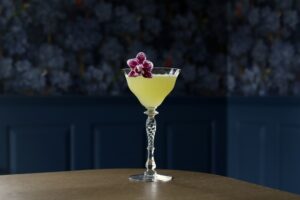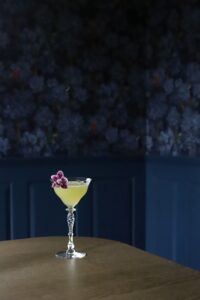
My favorite thing about this blog has been making and writing about classic cocktails with rich histories. I don’t do it as often these days, since I’ve covered most of the big ones, but there are always more out there, and some of them are real gems. This is definitely one of them.
The Hotel Nacional is a daiquiri variation made with pineapple juice and apricot liqueur. These additions give it an extra burst of tropical flavor with a wonderful depth and richness. There are countless recipes floating around, all tailored to individual tastes. I tried a few different combinations for mine, and found that I enjoyed the one below the most. I liked the richness that an aged rum added to the drink, and I highly recommend using fresh pineapple juice if possible. You can certainly omit the simple syrup if you like your drinks more tart.
History of the Hotel Nacional Cocktail
Like so many classic rum cocktails, the Hotel Nacional hails from Cuba. It’s named for the hotel where it was created. The Hotel Nacional, which opened in 1930, is a landmark in Havana, and has hosted many celebrities and (notoriously) mafia bosses over the years. It fell under siege during the Cuban Revolution in what is now known as the Battle of the Hotel Nacional de Cuba. It remains in operation today.
Since Prohibition was still ongoing in the United States when it opened, the Hotel Nacional was able to snag some pretty amazing ex-pat bartenders: Eddie Woelke, Fred Kaufman, and Wil P. Taylor. Woelke is best known for tweaking and popularizing the El Presidente, Kaufman for (probably) creating the Mary Pickford, and Taylor for the Hotel Nacional. However, since they were all working there together, it’s likely that they collaborated on many of these recipes.

The first appearance of the Hotel Nacional in print is in the 1934 book Bar La Florida Cocktails. The Bar La Florida, now known as El Floradita, is famous for being one of Hemingway’s favorite haunts and the birthplace of his eponymous daiquiri. This little cocktail book contained popular local drinks, including the Hotel Nacional. It’s called the National Cocktail in the book, as the hotel was under American management and called the National Hotel of Cuba until 1933. The recipe notably lacks lime juice. It calls for only 1/2 oz. Bacardi rum, 1/4 oz. apricot brandy, and 1/4 oz. pineapple juice, making it a tiny drink as well.
The following year, Albert Stevens Crockett included the National in the “Cuban Concoctions” amendment to the Old Waldorf Astoria Bar Book. Taylor was the last resident manager of the Old Waldorf Astoria in New York, and the book places the National (which they say is also called a Daiquiri or Bacardi at Taylor’s bar) first in its list of Cuban cocktails “out of compliment to Mr. Taylor.” Crockett’s recipe calls for equal parts Bacardi and pineapple juice, a squeeze of lemon, and a dash of apricot brandy. He also notes that it is served in a tall glass instead of a coupe, and that he prefers when white Bacardi is used.
Finally, Charles Baker writes about “Wil P. Taylor’s Hotel Nacional Special” in his 1939 Gentleman’s Companion, where he dubs the Hotel Nacional “one of the three finest Bacardi drinks known to science” (the other two being the Daiquiri and Mojito). His recipe is 1 jigger each of Bacardi and pineapple juice, 1/2 jigger lime, and a teaspoon of apricot brandy. Unlike Crockett, Baker prefers gold rum in his Hotel Nacional, as he says that the Carta Blanca is too delicate in flavor.
Both Crockett and Baker also praise Taylor for his fortitude during the Cuban Revolution. Crockett says that Taylor “stuck at his post all through the recent local disturbances,” and Baker, who visited shortly after the Battle of the Hotel Nacional de Cuba, writes that Taylor “kept right on managing, just as if it had been old times!”
Hotel Nacional
1.5 oz. aged rum
3/4 oz. pineapple juice
1/2 oz. lime
1/4 oz. simple syrup
1/4 oz. apricot liqueur
Combine all ingredients in a shaker with ice. Shake until chilled and strain into a coupe or champagne flute. Garnish with a lime wedge and/or an edible flower.





